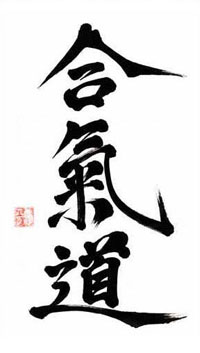The essence of Aikido as a martial art
|
|
| Aikido written in japanese kanji. |
Aikido is a Japanese martial art developed by Morihei Ueshiba (1883-1969) which emphasizes harmonization over contention when dealing with aggression and conflict. What does this mean in practice? That our intent, and consequently our actions, in dealing with aggression (whether physical, verbal or otherwise) is not to take a position of resistance or struggle but rather join with the force of the opposing party, making it our own before leading it into a resolution where it's energy and ideally, it's own aggressive intent, has been neutralized.
Aikido is thus a martial art that goes beyond the standard martial 'win or lose' options when dealing with attack and offers another way of managing conflict.
This ideal of moving from a situation of conflict to it's harmonious resolution is not just a philosophical proposition. It must be realized through our whole being and reflected in our actions and particularly our actions when under pressure which is when they are most critical. Through confrontational and physical training we learn gradually to let go of our reactive and habitual tendencies to defend, block and struggle and instead open up to the power of being open and undefended, paradoxical and nonsensical as this may at first seem.
In remaining open under pressure we are in a far better space to ascertain more accurately what is actually the reality of a given situation and in remaining loose and free from fearful defensive postures we are in a better place to respond with greater flexibility and freedom.
Defensiveness and stiffness are just not as functional as a strategy for conflict management when compared with openness and flexibility.
In this sense, Aikido is a discipline where mind and body are seen as inextricable aspects of a whole from the very beginning of training. Our fears and mental positions reflect themselves faithfully in our bodies as stiffness ("armoring"), loss of balance and therefore, lack of freedom. The direct experience of resistance and struggle in the training process with our partners shows us clearly where we are stuck and blocked and thus where the work of freeing ourselves needs to be directed.
Men are born soft and supple;
dead, they are stiff and hard.
Plants are born tender and pliant;
dead they are brittle and stiff.
Thus whoever is stiff and inflexible
is a disciple of death.
Whoever is soft and yielding
is a disciple of life.
The hard and stiff will be broken.
The soft and supple will prevail.
Tao te Ching. Chapter 76.
Schools and styles of Aikido
The founder of Aikido Morihei Ueshiba (also know as O Sensei and henceforth referred to as such) developed his art over the course of a long life of training and experience and consequently went through many phases in it's development and maturation.
Today we see a plethora of different schools of Aikido all over the world, from the very 'hard' physically oriented styles with a greater combat emphasis to the more 'soft', health and exercise oriented approaches. This reflects the many students that O Sensei had at different times during the development of his art who then went off to establish their own schools with their own philosophical interpretations and distinct didactic approaches. Furthermore, no tradition stands still in its development and Aikido continues to evolve and change, particularly as it spreads out vigorously beyond its native and cultural origins around the world. This variety of interpretation and expression is part of the rich legacy and potential of the art.
Aikikai Aikido
In the Macedonian Aikido Federation we follow the mainstream line represented by the Aikikai Foundation, an organization founded by the creator of aikido himself. More precisely, we learn and teach aikido by the didactical system made by one of the most famous Aikikai shihans – Masatomi Ikeda sensei. He named it Sanshinkai (triple core system).
It can be characterized by it's emphasis on the following subjects:
* Systematized basics training and a clear understanding of the reasons that leads to applying a certain technique.
* No attack - No defense.
* Practice with weapons (wooden sword, staff and knife).

